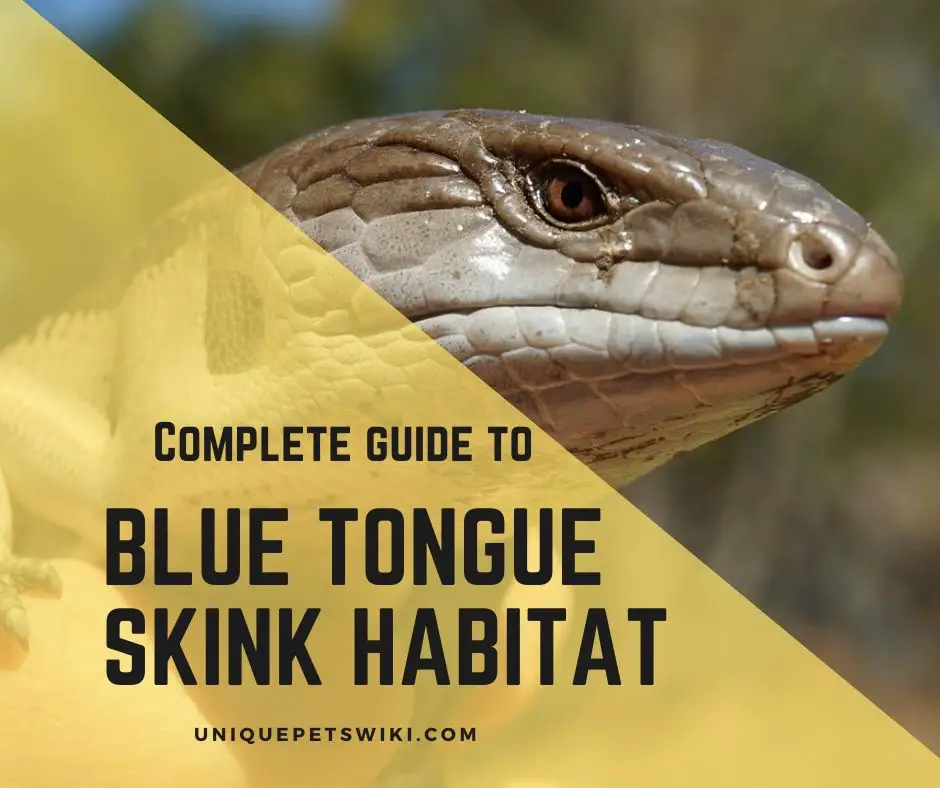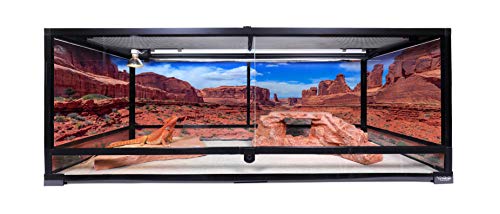There might be several species of blue tongue skinks. However, they all need almost the same type of habitat. Mostly, you will find them in grasslands, woodlands, agricultural areas, and they can easily adapt to urban areas.
Blue tongue skinks are terrestrial animals. Thus, you will mostly find them on the ground rather than on trees because they are usually thick and have very short stumpy legs, which makes climbing difficult for them.
Therefore, they are more burrowing animals than climbers.
In captivity, it is essential to make their habitat as natural as in the wild. Thus, setting up blue tongue skink habitat in captivity is critical.
In this article, we will help you set up a suitable habitat for your blue tongue skink that will help them to thrive in captivity.
Contents
- The Best Blue Tongue Skink Setup at Glance
- What Your Blue Tongue Skink Needs in Their Habitat
- Enclosure (Tanks)
- Recommended Blue Tongue Skink Tank Size
- Substrate (Flooring)
- Landscaping and Furniture Needs (Branches, Rocks, Etc.)
- Temperature
- Secondary Heat Source
- Light (Different Kinds of Light)
- Water and Humidity
- Décor (Background)
- Conclusion
The Best Blue Tongue Skink Setup at Glance
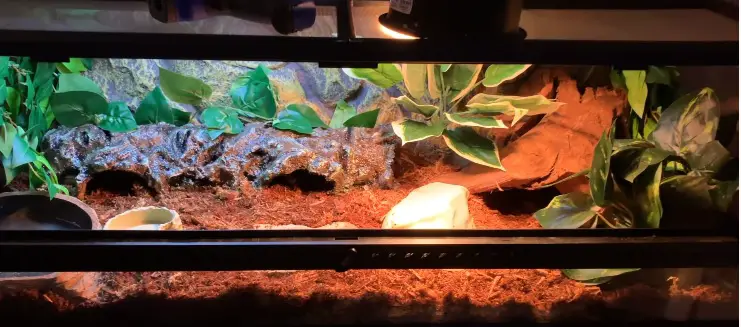
(Source: Elle’s Reptiles YouTube)
What Your Blue Tongue Skink Needs in Their Habitat
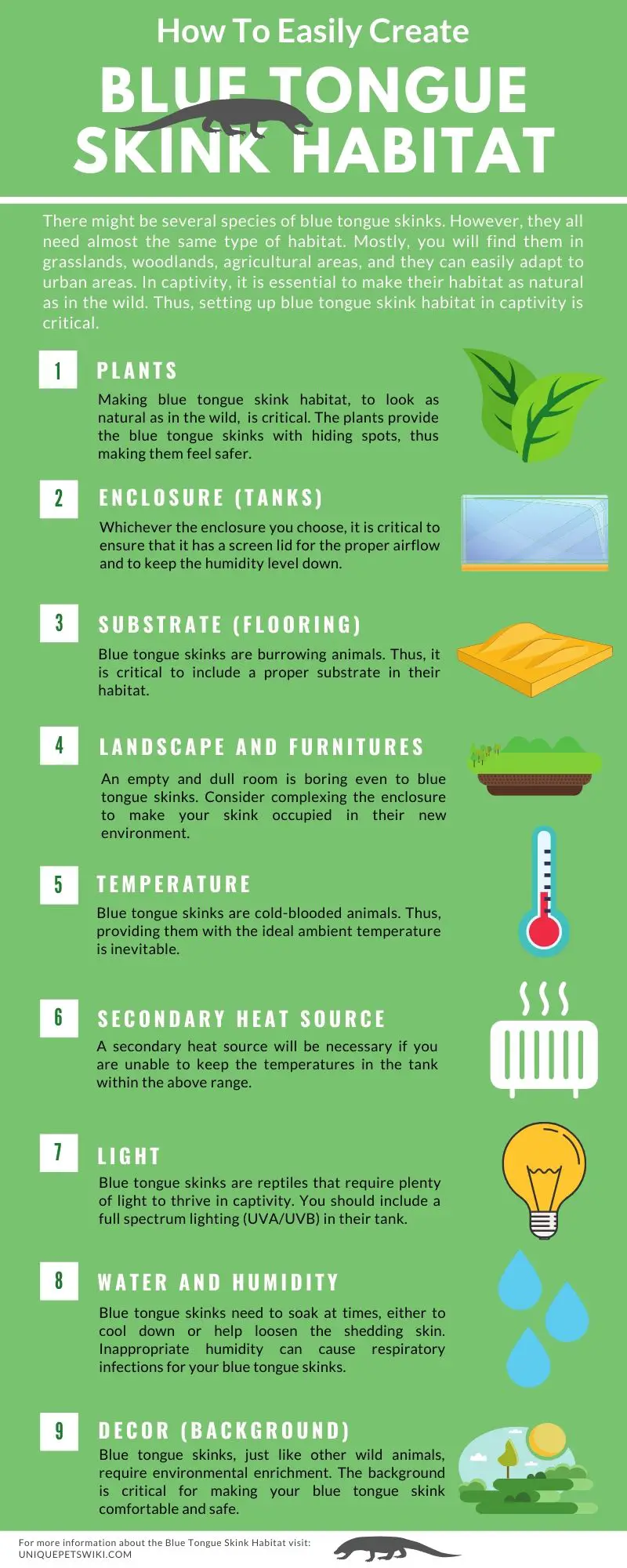
The natural habitat for blue tongue skinks is in Australia and Indonesia. Depending on the origin of your blue tongue skink, you must make their habitat similar to that. But, one thing is for sure, regardless of the blue tongue skink origin, they all need UVA, UVB, warmth, and the right humidity.
Beginners’ blue tongue skinks keepers tend to go for the convenient “all in one” enclosures at the pet stores. However, it’s not the best habitat for blue tongue skinks.
It is because they don’t include the best environmental enrichments for blue tongue skinks, but the most affordable equipment.
For instance, the thermometers that come with the package are usually inaccurate and unreliable to measure the ambient temperature.
Enclosure (Tanks)
There are varieties of tanks to choose from in the market. They range in prices, sizes, functionality, and even the manufacturing materials.
Whichever the enclosure you choose, it is critical to ensure that it has a screen lid for the proper airflow and to keep the humidity level down.
You must also include UVB, UVA, ceramic heat emitter, basking lights to make your blue tongue skink comfortable and functioning well.
Keep reading for better ideas on the best enclosures for your blue tongue skinks.
Glass Terrariums
Pros
- They are very similar to fish tanks. They are the best option if you would love to have a 3600 view option. However, it is advisable to include background on one side.
- Glass terrariums are very much available in most of the pet shops. They are also durable and easy to clean.
- Also, the glass terrariums make a good habitat for blue tongue skins because they have a screen lid on the upper side that allows ample airflow and regulates the humidity levels.
Cons
- They are not good conductors of heat. Thus, they do not keep the habitat warm enough as other types of habitats. Not the best insulator.
Plastic Enclosures
Pros
- They are lightweight and have a smooth finish.
- They are mostly sold in a range of colors.
- Also, the seller can install lights as per your request at an additional fee.
- They can blend into your home décor
- Good conductors of heat. Thus, they can hold heat quite well.
Cons
- Quite expensive
- Not so good for regulating humidity levels. They do not allow proper airflow.
Vision cages
Pros
- They are made of a single plastic and have inbuilt light fixtures
- Easy to clean and overcome chemical resistance
- They are lightweight and stackable
Cons
- Very expensive
ABS Cages
Pros
- Very similar to both vision and PVC cages
- They are lightweight
- Easy to clean
- Stackable able
- Does not emit plastic odor and toxins that other plastics emit
Cons
- Very expensive
Wood enclosures
Pros
- Very heavy and sturdy wood
- The best insulator
- Best for keeping your blue tongue skink warm
- Since its white, it reflects more light and thus keeps your blue tongue skink colorful
Cons
- It is heavy
- It’s expensive
- Easily ruined if kept wet.
New to blue tongue skink? Check out the blue tongue skink care sheet now! We had listed out all the things you need to know about blue tongue skinks as pets. Check it now!
Plywood cage
Pros
- It is custom made, thus cheap
- Lightweight
Cons
- If you use toxic seals, they can affect your blue tongue skinks
Last update on 2022-12-30 / Affiliate links / Images from Amazon Product Advertising API
Recommended Blue Tongue Skink Tank Size
The size of your blue tongue skink tank entirely depends on the size of your pet. However, the general rule for the best tank should be a tank that is two times larger than the size of your skink.
Even if you have a baby blue tongue skink, it is best if you would set up a large tank as your pet will be growing fast.
If you go for a small tank from the beginning, you will have to keep replacing it with a larger tank as your pet grows.
Blue tongue skinks are large compared to other lizards. A blue tongue skink can grow up to 24”. And since blue tongue skinks are more likely to burrow than to climb, it is critical to ensure that you provide a spacious floor.
Terrariums that open from the front are more convenient compared to those that open from the top.
The best size for an adult blue tongue skink is 55 gallons and above. However, for baby blue tongue skink, you can start with a 40-gallon tank.
Again, you should always keep in mind that blue tongue skinks are antisocial animals. Thus, you should only house them individually.
Substrate (Flooring)
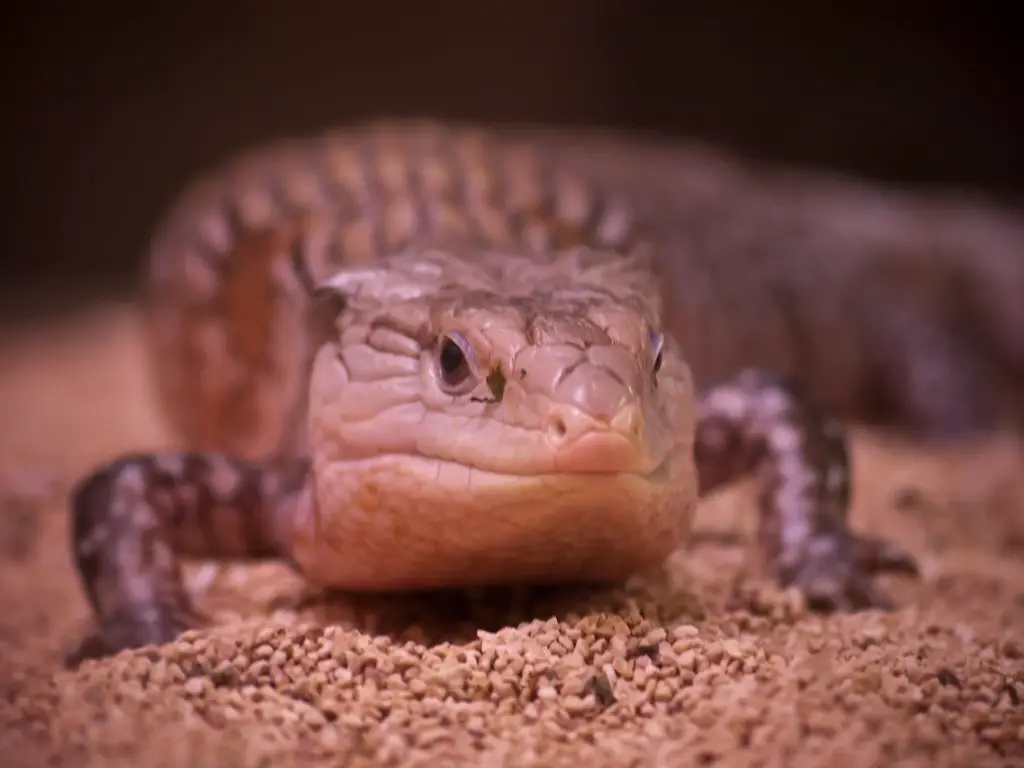
Blue tongue skinks are burrowing animals. Thus, it is critical to include a proper substrate in their habitat. To make them comfortable, you should at least include a substrate that is 4-6 inches deep.
Before choosing the best substrate for your blue tongue skink, you should first try to understand their origin.
For instance, Australian blue tongue skinks require a dry substrate, while Indonesian skinks require a humid substrate.
There are two types of substrates, loose particle and non-particle substrates.
Loose Particles Substrate
A loose-based substrate is typically loose. Those substrates can produce dust and debris that are ingestible by your blue tongue skinks.
Thus, they expose your blue tongue skink to impaction. Clogging of your blue tongue skink digestive system is what is referred to as impaction. In return, it becomes difficult for your blue tongue skink to move bowels.
This condition is extremely serious and can cause death for your blue tongue skink.
Also, the dust can get into your blue tongue skink’s eyes and nose, causing infection.
Here is a list of loose particle substrate that you should never use for your blue tongue skinks
- Wood chips/ shavings
- Play sand
- Gravel
- Calcium sand
- Alfalfa pellets
- Walnut shells
- Millet
However, blue tongue skinks are burrowing animals. Thus, they require a soft, loose substrate to burrow in. And, even though wood chips are inadvisable, you can use shredded wood bedding rather than shavings.
One of the best wood beddings for blue tongue skinks is Aspen wood bedding.
Aspen wood bedding
It is one of the best substrates to use for all blue tongue species. It is the perfect match as it’s soft, light and can absorb the waste and smell. Also, it creates a natural habitat for blue tongue skink in the terrarium.
However, you should only use filtered and hypoallergenic aspen wood beddings. It is because; they do not contain excessive dust capable of causing respiratory health issues.
Also, it is difficult for your blue tongue skinks to ingest larger pieces of wood, and therefore, cannot cause impaction.
You should NEVER use thin and dusty aspen beddings. They are ingestible, and the dust can cause respiratory infections to your blue tongue skinks.
Non-Particle Substrate
It is the best and safest type of substrate for blue tongue skinks. They do not cause impaction or eye and nose infection. It is because they do not contain ingestible dust.
Here is a list of the best non-particle substrate
- Reptile carpet
- Paper towels
- Ceramic tile
- Newspaper
However, these substrates do not go without blame.
For instance, your blue tongue skink’s claws can be stuck on the carpets thread. Also, reptile carpet can’t compare to their natural habitat. Besides, your blue tongue skink being burrowing animals, they might try to burrow under the carpet.
And, ceramic tiles are slippery and thus, not so comfortable for blue tongue skinks. Thus, you should ensure that you lay down the non-toxic adhesive and topsoil to give it a grip.
Cleaning
Blue tongue skinks get dirty quickly, and thus, cleaning their enclosures is essential. Poor sanitation can cause health issues to your blue tongue skinks.
Whichever substrate you choose to use, you should ensure that you remove any droppings as soon as they appear.
Also, you should ensure that you disinfect the enclosure at least once a month. And, thoroughly clean your hands as soon as you are done handling the enclosure.
Landscaping and Furniture Needs (Branches, Rocks, Etc.)
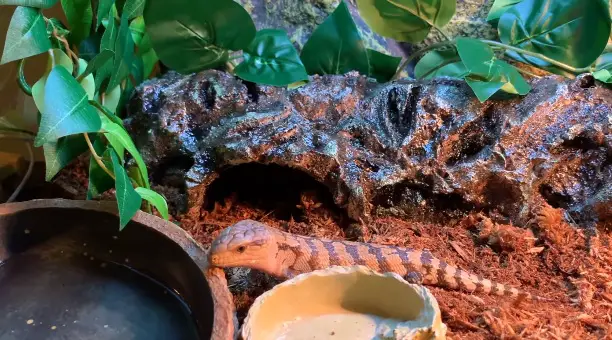
(Source: Elle’s Reptiles YouTube)
Can you imagine living in a void house? It must be boring! Even for blue tongue skinks housing, it is critical to add accessories to make it comfortable and happy.
Let’s see some of those essential accessories for blue tongue skinks.
A rock or a branch
In the wild, blue tongue skinks have a habit of climbing on a rock when basking. In captivity, you should also provide them with a rock where they can comfortably sit and bask. The rock helps to rise above the ground level and be a bit closer to the UVB.
Blue tongue skinks need to bask for proper health and digestion. It is through basking that blue tongue skink acquires vitamin D3.
Plants
Making blue tongue skink habitat, to look as natural as in the wild, is critical. Thus, you should add plants in their tank. Also, the plants provide the blue tongue skinks with hiding spots, thus making them feel safer.
You can use live plants, but they are not the best as the blue tongue skinks are highly likely to destroy them when burrowing. Thus, you should consider using artificial plants.
Hides
Blue tongue skinks like to hide. A tank without hiding spots is highly likely to cause stress to your blue tongue skinks.
During the brumation period, blue tongue skinks spend most of their time hiding. Thus, hiding places for your blue tongue skink is a must.
You customary make one for your pet or buy from an online or retail pet shop near you.
Temperature
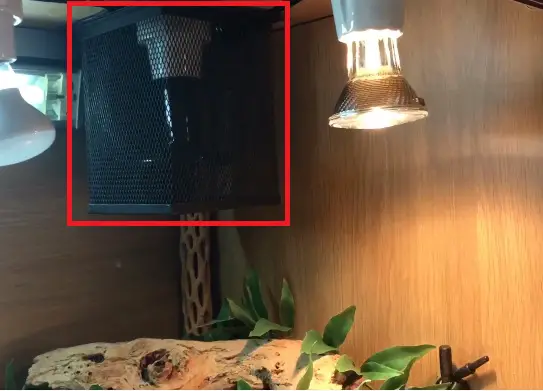
Blue tongue skinks are cold-blooded animals. Thus, providing them with the ideal ambient temperature is inevitable.
If you don’t provide your blue tongue skinks with the right temperature, they experience indigestion, which can be fatal.
Thus, what is the ideal temperature for blue tongue skinks?
Blue tongue skinks require a thermal gradient to set up their tank (one side than the other).
To make this possible, you can use the Zilla Heat Mat.
The ideal temperature for blue tongue skinks is 75-800F on the cool side and 80-850F on the warm side.
Also, you should provide a basking area that is 95-1000F. To ensure that the temperature is on point, you should at least have two separate thermometers.
Secondary Heat Source
It’s natural for blue tongue skinks to spend most of their day basking in the wild. As such, it is critical to provide a warm basking area for them in captivity.
The best temperature for the basking area should be 1000F for adults and 1100F for babies blue tongue skinks.
To keep the temperature in range, you can consider buying a ceramic heat emitter. Under tank heaters are not the best options as they can either overheat the blue tongue skink tank or short and burn your pet.
New to blue tongue skink? Check out the blue tongue skink care sheet now! We had listed out all the things you need to know about blue tongue skinks as pets. Check it now!
During the night, the temperature can drop up to 650F. And if you have to heat your blue tongue skink enclosure at night, ensure that you use a non-light emitting heat source.
Putting off the lights at night in your blue tongue skink cage will help them have a clear day-night cycle.
But, to monitor and control the cage temperature for your blue tongue skink, you should install a thermostat.
The thermostat ensures that the ceramic heat automatically starts to heat at night when the temperature goes below 800F.
Light (Different Kinds of Light)
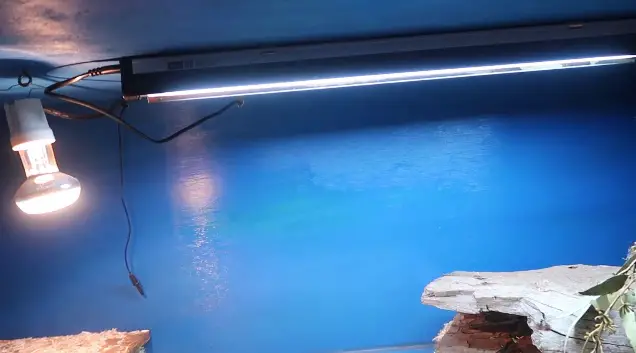
(Source: Coop’s Reptiles YouTube)
Why blue tongue skinks need UVB
Blue tongue skinks are reptiles that require plenty of light to thrive in captivity. Even in their original habitats, which are commonly Australia, blue tongue skinks enjoy plenty of light during the day.
Thus, you should include a full spectrum lighting (UVA/UVB) in their tank.
UVB is responsible for replacing the sun rays emitted by the sun in the wild. UVB lighting is critical for proper digestion in blue tongue skinks.
On the other hand, UVA light is responsible for helping your skink differentiate between the night and day. UVA’s main purpose is to provide light for your blue tongue skink.
You should not include either UVB or UVA light at night since blue tongue skinks are diurnal animals that need to sleep at night.
If you don’t provide enough UVB and UVA during the day, your blue tongue skink is highly likely to get the metabolic disease.
Metabolic disease is a common health issue for blue tongue skinks in captivity. It is caused by a lack of enough calcium and vitamin D3.
Whether reptiles need UVB to survive has been a hot topic amongst hobbyists. Some say that reptiles can survive without UVB in captivity. They say that you can supplement UVB with dietary vitamin D3.
However, veterinarians’ research argues that a good amount of UVB in reptiles leads to high levels of health in their bloodstreams.
Therefore, you must ensure that you provide your blue tongue skinks with the appropriate amount of UVB in captivity.
The best UVB lighting should cover at least half of the tank’s total length. Thus, the best UVB light that we recommend is Zoo Med Reptisun 10.0 High Output UVB.
For the best results for your blue tongue skinks, you should replace the bulb every 12 months. Also, you should ensure that no plastic or glass is blocking the bulb.
You should also ensure that the UVB is not 10” near your blue tongues skink. Again, the bulb should not be too far from your blue tongue skink.
Water and Humidity
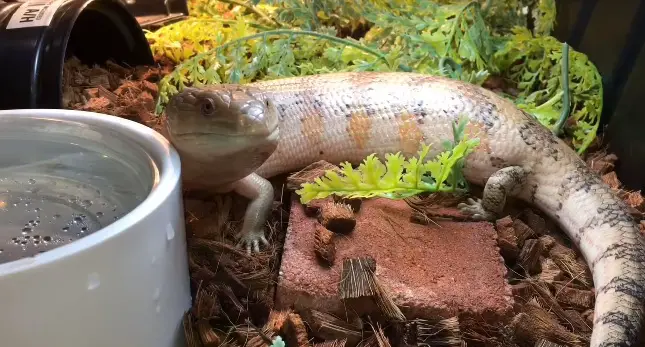
(Source: ReptileMountain.TV YouTube)
Water
A water bowl is an equipment that you should always include in a blue tongue skink cage. Even though you might never see your blue tongue skink drink water, it is essential to ensure that it is always accessible.
It is because blue tongue skinks need to soak at times, either to cool down or help loosen the shedding skin.
Therefore, you should ensure that the water bowl is big enough for your blue tongue skink to soak in. However, blue tongue skinks are not good swimmers, and thus, the bowl should not be too deep.
A deep water bowl can lead to your blue tongue skink drowning.
Another important thing to remember when providing your blue tongue skink with water is that distilled water is better than tap water.
Humidity
Inappropriate humidity can cause respiratory infections for your blue tongue skinks. Thus, it is important to ensure that you provide the ideal humidity.
Australian blue tongue skinks require a humidity level that is around 40%. Indonesian species, on the other hand, will require humidity ranging from 60-80%.
Thus, the amount of humidity to provide to your blue tongue skinks entirely depends on the origin of your species.
Even so, the humidity requirement also varies from one species to another. For instance, Blotched, Northern, and Eastern blue tongue skinks require humidity of 40-50%.
On the other hand, Shingle back, Central, and Western blue tongue skinks require 20-40% humidity.
Kei Island and Irian Jaya blue-tongue skinks require a humidity of 60-80%.
To enhance the required amount of humidity for your blue tongue skinks, you will need to acquire a digital hygrometer. The best hygrometer that we recommend is Zoo Med Digital Thermometer and Humidity Gauge.
Tricks for maintaining humidity
- Even when you are using the best substrate, it does not guarantee the appropriate humidity. Thus, you should ensure that you mist the substrate daily with a spray bottle or a pressure sprayer.
- You can mix the substrate with water manually until it’s dumped, but not wet.
- Also, you can invest in a reptile fogger for long-lasting humidity effects.
The best way to check if you are providing the appropriate humidity for your blue tongue skinks is to observe its belly scales. Rough scales indicate that your pet needs more moisture, while silky, smooth, and a good shedding indicates you are doing okay.
Décor (Background)
Blue tongue skinks, just like other wild animals, require environmental enrichment. “Environmental enrichment” is the process at which you dynamically enhance the captive habitat to look more or the same as their original habitat.
There are five categories of enrichments for wild animals in captivity.
- Social
- Cognitive
- Physical habitat
- Sensory
- Food
In this case, background décor falls under cognitive enrichment. Thus, good decors for blue tongue skinks or any other reptile is essential. It is because; apart from making the terrarium cool, they also stimulate the reptile’s mind and keep them healthy.
They are also known as environment enrichments for reptiles. Let’s see why your blue tongue skink needs background decors, as part of environmental enrichment.
Why you need a background?
Cognitive enrichment
The background is critical for making your blue tongue skink comfortable and safe.
It is because; a good background resembles the blue tongue skink habitats. It is also critical for preventing glass surfing.
Glass surfing is when you see your blue tongue skink scratching the glass. It is a sign of a stressed blue tongue skink.
Conclusion
That’s it about blue tongue skink habitat.
Blue tongue skinks can easily get bored in captivity. Thus, ensuring that you mimic their natural habitat is essential.
To help them thrive rather than survive in captivity, you should provide them with adequate temperature, lighting, and humidity.
You should also ensure that you are using the best substrate that does not impose any risk on your blue tongue skink.
We wish you all the best with your blue tongue skink!
